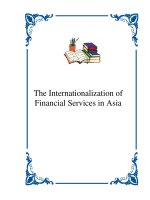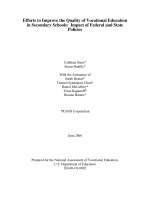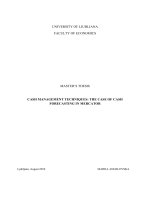THE DYNAMICS OF FUNCTIONAL MEANINGS IN DISCOURSE
Bạn đang xem bản rút gọn của tài liệu. Xem và tải ngay bản đầy đủ của tài liệu tại đây (11.42 MB, 196 trang )
THE DYNAMICS OF FUNCTIONAL MEANINGS IN
DISCOURSE
Volume II
LOH BOON LIANG
(B.SC. (HONS), NUS)
A THESIS SUBMITTED FOR
THE DEGREE OF MASTER OF ARTS (ENGLISH LANGUAGE)
DEPARTMENT OF ENGLISH LANGUAGE AND LITERATURE
NATIONAL UNIVERSITY OF SINGAPORE
2010
TABLE OF CONTENTS
Volume II
TITLE PAGE ............................................................................................................. i
TABLE OF CONTENTS........................................................................................... ii
APPENDICES....................................................................................................... 227
Appendix 1
Clauses of the Text .....................................................................227
Appendix 1.1 Main Story (852 words) ......................................................227
Appendix 1.2 Ten (Last) Comments (990 words)......................................230
Appendix 2
SF Analysis of Clauses ...............................................................234
Appendix 2.1 Main Story..........................................................................234
Appendix 2.2 Comments ..........................................................................332
Appendix 3
SF Analysis Matrices ..................................................................368
Appendix 4
Theme/Rheme Calculation .........................................................385
Appendix 5
SVD Definition ..........................................................................387
Appendix 6
SVD Plots ..................................................................................390
Appendix 6.1 Main story ..........................................................................391
Appendix 6.2 Comments ..........................................................................410
Appendix 7
The Grammar .............................................................................413
Appendix 7.1 Clause Page ........................................................................413
Appendix 7.2 Interclausal Page .................................................................418
Appendix 7.3 Discourse Page ...................................................................419
ii
_____________________________________________________________________
APPENDICES
_____________________________________________________________________
APPENDIX 1
CLAUSES OF THE TEXT
Appendix 1.1
Main Story (852 words)
1
2
3
4
5
6
7
8
9
10
11
12
13
14
15
16
17
18
19
20
21
22
23
24
October 10, 2008 -- Updated 1136 GMT (1936 HKT)
Commentary:
Why there 's a crisis
-- and how to stop it
- CNN.com
At this point in the credit crisis, at least one thing is certain
: most policymakers lack a clue of what is really at stake.
Those with some knowledge are driving policy
looking through the rearview mirror.
Begin with the U.S. Treasury's $700 billion bailout package.
This was presented as some magic pill
which, if gulped down, would quickly restore financial stability.
The "shock and awe" of the sheer size of the taxpayer-funded bailout would
somehow restore confidence.
Instead, stock markets collapsed
and credit markets remained frozen.
This is because the credit crisis reflects something more fundamental than a
serious problem of mortgage defaults.
Global investors, now on the sidelines, have declared a buyers' strike against
the sophisticated paper assets of securitization that financial institutions use to
measure and offload risk.
In recent years, our banks, borrowing to maximize the leverage of their assets
at unheard-of levels, produced mountains of financial paper instruments
(called asset-backed securities) with little means of measuring their value
Incredibly, these paper instruments were insured by more dubious paper
instruments.
Therefore, the housing crisis was a mere trigger for a collapse of trust in paper,
followed by a de-leveraging of the entire global financial system.
As a result, we are experiencing the painful downward reappraisal of the value
of virtually every asset in the world.
So what are these paper instruments, these asset-backed or mortgage-backed
securities?
227
25
26
27
28
29
30
31
32
33
34
35
36
37
38
39
40
41
42
43
44
45
46
47
48
49
50
51
52
53
54
55
56
57
58
I like to use a salad analogy.
Before the last decade, bankers simply lent in the form of syndicated loans.
But with the huge expansion of the global economy in the 1990s, which
produced an ocean of new capital, the bankers came up with an idea called
securitization.
Instead of making simple loans
and holding them until maturity,
a bank collected all its loans together,
then diced
and sliced them up into a big, beautiful tossed salad.
The idea was to sell (for huge fees) individual servings of diversified financial
salad around the world.
The only problem: under an occasional piece of lettuce was a speck of toxic
waste in the form of a defaulting subprime mortgage.
Eat that piece of salad,
and you're dead.
The overall salad looked delicious,
but suddenly global investors were no longer ordering salad.
No one knew the location of the toxic waste.
This distrust heightened
when global interest rates began to rise.
So what does this salad boycott mean for the future
and why have financial markets collapsed so brutally?
The markets are telling us
the world will face a serious credit crunch in 2009
regardless of how much money government spends
to remove the toxic salad from bank balance sheets.
Policymakers have no means of forcing the banks to start lending
short of nationalizing the entire financial system.
After all, the U.S. banks alone so far during the crisis have lost upwards of $2
trillion from their collective asset base.
Most banks are leveraged by more than 10 to 1.
Translation: The U.S. financial system will have a whopping $15 trillion to
$20 trillion less credit available next year than was around a year and a half
before.
The cost of money is rising
and the availability shrinking.
True, the banks will still lend
-- but the fear is they will do it only to people such as Warren Buffett,
who don't need loans.
What is uncertain is the amount of lending to borrowers engaged in
entrepreneurial risk, the center of business reinvention and job creation.
228
59
60
61
62
63
64
65
66
67
68
69
70
71
72
73
74
75
76
77
78
79
80
Apart from the economic pain resulting from shrinking credit markets, we are
about to see an earthquake in the relationship between government and
financial markets.
The great uncertainty is whether government has the power to rescue the
financial system in times of crisis.
It seems doubtful.
In the United Kingdom, for example, the collected assets of the major banks
are four times the nation's gross domestic product (GDP).
A similar situation exists in many Euro zone countries.
This means government cannot bail out the system even if it wanted to.
Given such massive exposure, government guarantees in a time of crisis
become meaningless.
Yet because of the interconnected web of global financial relationships, we are
all vulnerable to the threat.
The collapse of, say, a major European bank would hardly leave American
workers immune.
Our policy leaders in Washington are thinking domestically
when the solution to the credit crisis will be global.
It is not that the world lacks money;
it is that the world's money is sitting on the sidelines
-- more than $6 trillion in idle global money markets alone.
The challenge will be to reform our financial system quickly
to draw that global capital back into more productive uses.
The first step should be efforts to make the market for future asset-backed
paper more transparent and credible.
We need a private/public global bank clearing facility.
The bankers don't trust each other.
The central banks, working with the private institutions in providing enhanced
data, need to begin to refashion the world's financial architecture.
And while that is happening,
the major governments of the world, including the Chinese, should begin
major fiscal efforts to stimulate their weakening economies.
229
Appendix 1.2
1
2
3
4
5
6
7
8
9
10
11
12
13
14
15
16
17
18
19
20
21
22
23
24
25
26
27
28
29
30
31
Ten (Last) Comments (990 words)
Commentary: Why there's a crisis -- and how to stop it - CNN.com
Sound Off: Your opinions and comments
1. RCE
One easy way to stop the market volatility would be to make permanent the
ban on short sales, across the board.
Take the short sales out of the market
and you will see reduced market volatility.
2. Professor Bear
It is much easier to explain the disaster in progress than to specify a remedy
-- sort of like noticing a tsunami is about to hit a coastal community is much
easier than figuring out how to evacuate the community in time to save
everyone.
3. P
I truly do wonder
how all these professionals, people who are paid for their knowledge of the
workings of the nation's and the world's financial dealings, did not foresee the
impending collapse of this house of cards built out of these toxic paper
instruments?
It seems that for a long time your slightly above average Joe Sixpack knew
the bubble was going to burst.
How could these highly paid professionals have been blind to it?
Or were they perfectly aware of the situation
and playing chicken with the world's economy,
assured by their golden parachutes
if they swerved too late
that they would be able to ride out the chaos they had created?
Next time around I hope
there is someone willing to point out the elephant in the room and the fact the
emperor has no clothes,
well, that someone with some power would.
It's not even a matter of regulation vs. de-regulation.
It is a matter of personal responsibility vs. corporate greed.
Forsaking all in the pursuit of profit is not the foundation of a sound economy.
Why weren't the boards of directors seeking sound investments instead of the
quick buck?
Why were investors willing to ignore the fact they were participating in a
dangerous pyramid scheme?
230
32
33
34
35
36
37
38
39
40
41
42
43
44
45
46
47
48
49
50
51
52
53
54
55
56
57
58
59
60
61
62
63
64
65
66
67
Why was Joe Sixpack getting a mortgage for a house he couldn't afford to
maintain let alone pay for?
4. Jared
We are caught in a vicious cycle right now
and nobody seems to be able to pull us out of it or point to where the problem
lies.
We wake up each morning
to find
that Asian & European markets have plummeted
and thus ours plummets.
On the other side of the globe they wake up
to see
that American markets have plummeted
and theirs plummets in kind.
The media reports on it
and everyone panics,
snowballing the situation
and making it worse.
We are in a downward spiral
and people's fears are only making it worse.
Pulling all of your money out of stocks right now is not only a hasty decision
that you will regret,
but adding to the problem
and making things worse.
Unless you are on the cusp of retirement,
sit tight
and ride it out
and don't panic
because panic only adds to the problem.
5. gmakens
I believe one of the problems is with the credit default swap (CDS) market,
particularly what are called naked swaps.
A CDS is a contract between two parties
where the buyer pays a premium to the seller for protection against a debt
security (like a collaterized mortgage obligation or a company bond)
defaulting.
If the debt defaults,
the seller then needs to pay the buyer the par value of the debt.
This is basically an insurance contract against defaulting debt.
The problem is that speculators (hedge funds, etc) have bought this insurance
on debt they don't even own.
231
68
69
70
71
72
73
74
75
76
77
78
79
80
81
82
83
84
85
86
87
88
89
90
91
92
93
94
95
96
97
98
99
100
101
102
103
104
105
106
This is where the regulation has failed.
So now if a $1MM bond defaults,
and 100 speculators have bought a CDS on it,
the sellers of the CDS need to pay off that $1MM bond 100 times over.
How does this make economic sense?!
The reason for the credit squeeze is that the banks and financial institutions
who sold these swaps have to acquire as much cash as they can
in case they have to pay off on the defualts of the underlying debt.
They can't lend money
- they need to pay the speculators.
The credit crisis is not not going away
until this issue is addressed.
I think the government should make naked swaps illegal
- force all the financial institutions and speculators to unwind the contracts.
Have the sellers give the buyers thier premium back,
close the swaps,
and call it even.
Then the banks and financial instiutions won't have to hoard their cash
and instead can start loaning it out again.
The outstanding value of all the CDS is on the order of $50 TRILLION
dollars!!
The credit markets are not going to get back to normal
until this is addressed.
But that is just my opinion.
6. Steve
One of the comments on WASPs running Wall Street appears so.
Why is there no diversity?
Where there is money and power they try to control?
7. Texrat
Wow, a refreshing dose of common sense and reason.
Do we have time to write David Smick in for president?
8. Mike M
It's emotion fueling it now
so the media could help
by pulling back on the rabid coverage -- the amount of coverage and the way
its couched.
We do not need to see another "Is this another Great Depression" piece
when most Americans don't fully understand the complexity of the market nor
the full details of the Depression.
The press hype adds to the panic.
232
107
108
109
110
111
112
113
114
115
116
117
118
119
120
121
122
123
124
125
Watching every flicker of the Dow is not representative as well.
Do we even know
what 6,000 points means?
The average invesotr needs to ask themseklves:
Is that my price?
Some investors see it as a buying opportunity.
The President's near daily special press conferences also do not help,
especially having lost his credibility with Mission Accomplished.
9. Jonathan
If you really knew
"how to stop it,"
wouldn't you be a billionaire 700 times over?
10. Susan
Has anyone ever thought to do an in-depth analyses of Bush and his associates
finances?
I firmly believe they've gotten brutally rich during his term.
First with invading Iraq (oil)
then laying in bed with Wall St.
In all clauses presented in Appendix 1.1 and Appendix 1.2, the original form of the
text is preserved – including all misspellings and punctuation marks
233
APPENDIX 2
SF ANALYSIS OF CLAUSES
This is the most important section in the Appendices (and perhaps in the entire
thesis); the information in this section forms the basis of all discussions in the main
body of this thesis. Analysis at the level of the clause has been the basis of research in
linguistics through the ages. Here is a complete compilation of all the SF analyses, at
the level of the clause, of all clauses (as listed in Appendix 1: Clauses of the Text) of
the main story and comments. The clause analysis is presented in the form of
printouts from the Clause Page of Systemics.
Appendix 2.1
Main Story
SF analysis of the main story is comprehensive, spanning all metafunctions.
For a complete list of dimensions of meaning present within the main story analysis,
see Appendix 3: SF Analysis Matrices. The analysis includes the title: clause 3 & 4;
and 74 ranking clauses numbered 7 to 80.
Index to Appendix 2.1
Main Story Clause
clause 1
clause 10
clause 20
clause 30
clause 40
clause 50
clause 60
clause 70
clause 80
Page
236
240
255
266
276
287
302
314
330
234
For each clause the printout consists of two tables: Clause Table, followed by
the Analysis Table. The occasional Text Box beside the tables contains remarks,
sometimes explaining why I analysed clause elements in non-conventional ways.
235
236
237
238
239
policy: Range or Goal.
Range-like: policy is a plan or strategy, doesn't exist without the
action.
Goal-like: policy is developed/made/steered, impacted upon
240
mood met because it means "we're going to begin with..."
241
T1m = "presented as" = "appeared as"
242
243
244
"somehow" has some
interpersonal function,
expressing the author's own
misgivings about this
245
246
247
because="caused by (the fact that)"
(therefore process)
X causes Y (or X so Y)
Y is because X
(identifying)
248
249









